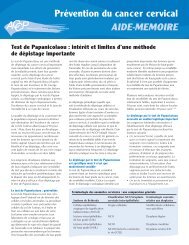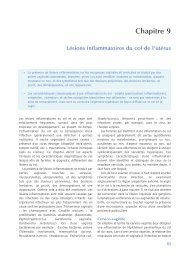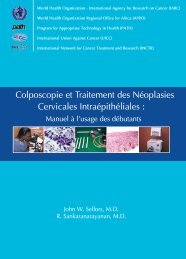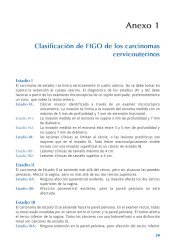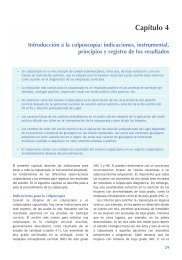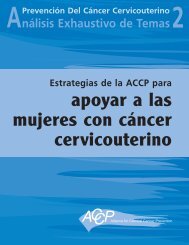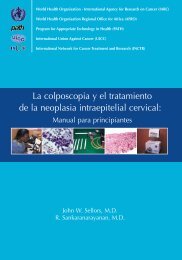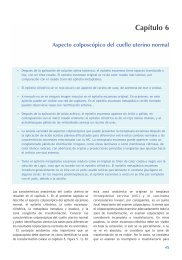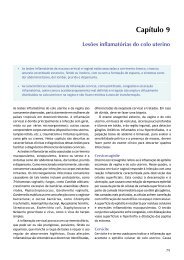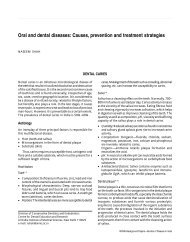Manual for Cytology - IARC Screening Group
Manual for Cytology - IARC Screening Group
Manual for Cytology - IARC Screening Group
Create successful ePaper yourself
Turn your PDF publications into a flip-book with our unique Google optimized e-Paper software.
Collection and Preparation of Material <strong>for</strong> Cytodiagnosis<br />
A. EXFOLIATIVE CYTOLOGY<br />
Female Genital Tract (FGT)<br />
The cytological specimens collected from FGT include cervical smear, vaginal smear,<br />
aspiration from posterior <strong>for</strong>nix of vagina (vaginal pool smear) and endometrial smear.<br />
Cervical smear: Cancer of the uterine cervix is the commonest cancer in the FGT. Almost<br />
all invasive cancers of the cervix are preceded by a phase of preinvasive disease, which<br />
demonstrates microscopically a continuing spectrum of events progressing from cervical<br />
intraepithelial neoplasia (CIN) grade I to III including carcinoma in-situ be<strong>for</strong>e progressing<br />
to squamous cell carcinoma. This progressive course takes about 10 to 20 years. Early<br />
detection even at the preinvasive stage is possible by doing cervical smear (Pap Smear<br />
Test). This can identify patients who are likely to develop cancer and appropriate interventions<br />
may be carried out.<br />
Advantages of Pap Smear:<br />
● It is painless and simple<br />
● Does not cause bleeding<br />
● Does not need anesthesia<br />
● Can detect cancer and precancer<br />
● Can identify non-specific and specific inflammations<br />
● Can be carried out as an outpatient procedure<br />
Patient Preparation: Proper patient preparation is the beginning of good cervical cytology.<br />
The patient should be instructed be<strong>for</strong>e coming <strong>for</strong> smear collection, that she should not<br />
douche the vagina <strong>for</strong> at least a day be<strong>for</strong>e the examination. No intravaginal drugs or<br />
preparations should be used <strong>for</strong> at least one week be<strong>for</strong>e the examination and the patient<br />
should abstain from coitus <strong>for</strong> one day be<strong>for</strong>e the examination. Smear should not be taken<br />
during menstrual bleeding, because of contamination with blood, endometrial component,<br />
debris and histiocytes.<br />
Sampling: A cervical cytological sample is considered satisfactory <strong>for</strong> cytological diagnosis<br />
when their composition reflects the mucosal lining of the cervix, encompassing ectocervical,<br />
squamous metaplastic cells and endocervical columnar cells in fair numbers. It is generally<br />
agreed that majority of epithelial abnormalities that eventually lead to an invasive cancer<br />
originate in the squamo-columnar junction (trans<strong>for</strong>mation zone). As stated by the British<br />
Society <strong>for</strong> Clinical <strong>Cytology</strong> (BSCC), a cervical smear if properly taken should contain cells<br />
from the whole trans<strong>for</strong>mation zone(TZ). The sample should contain a sufficient quantity of<br />
epithelial cells, and both metaplastic and columnar cells should be present. According to<br />
the Bethesda System, an adequate smear contains an adequate endocervical/trans<strong>for</strong>mation<br />
zone component. Lubricant should not be used while examining, as it can obscure the cells<br />
during smear examination.<br />
11



